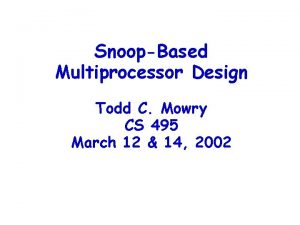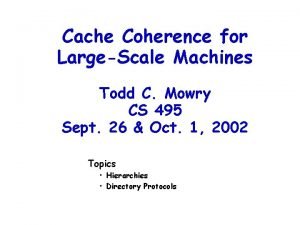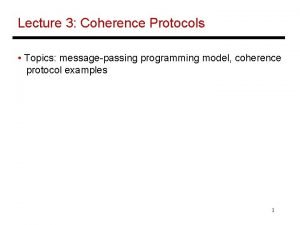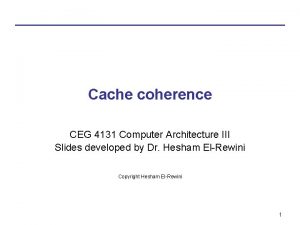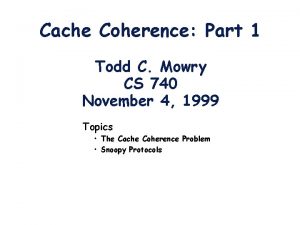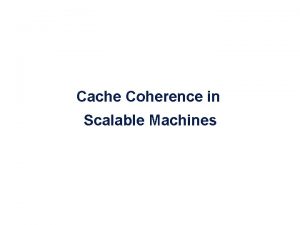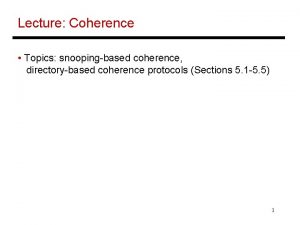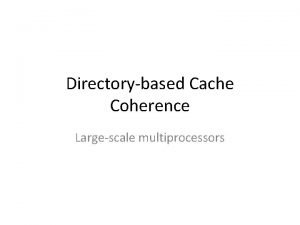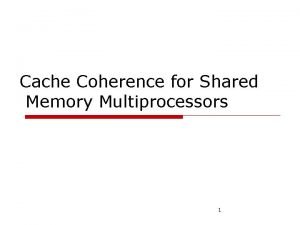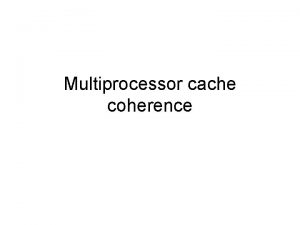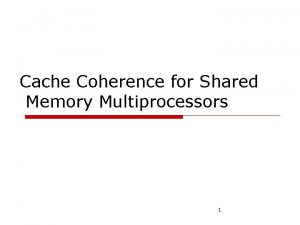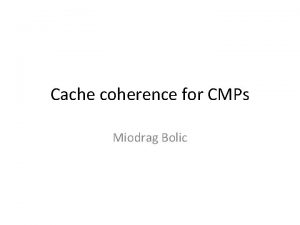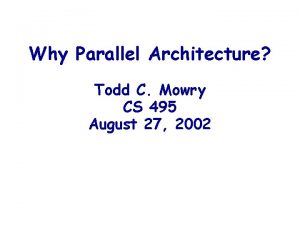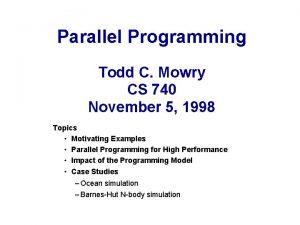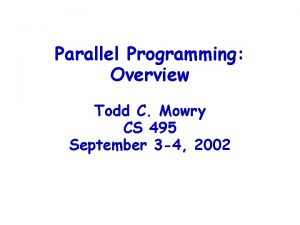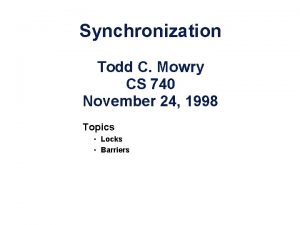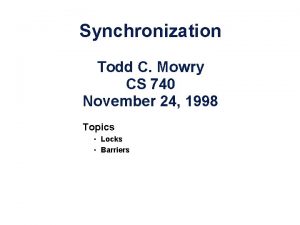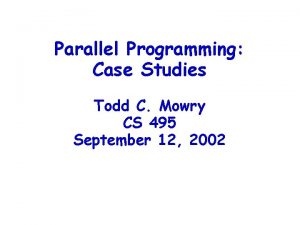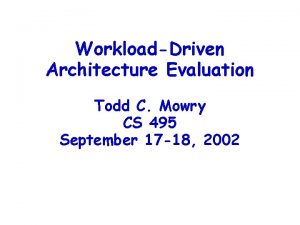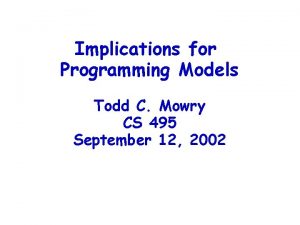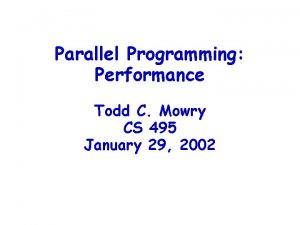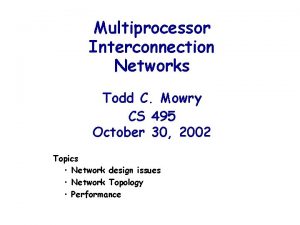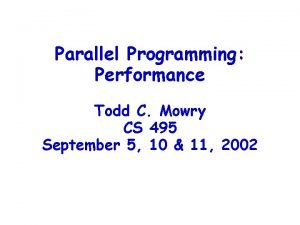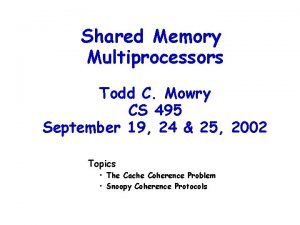Cache Coherence for LargeScale Machines Todd C Mowry





































- Slides: 37

Cache Coherence for Large-Scale Machines Todd C. Mowry CS 495 Sept. 26 & Oct. 1, 2002 Topics • Hierarchies • Directory Protocols

Hierarchical Cache Coherence • Hierarchies arise in different ways: (a) A processor with an on-chip and external cache (single cache hierarchy) (b) Large scale multiprocessor using a hierarchy of buses (multicache hierarchy) – 2– CS 495 F’ 02

Single Cache Hierarchies • Inclusion property: Everything in L 1 cache is also present in L 2 cache. • L 2 must also be owner of block if L 1 has the block dirty • Snoop of L 2 takes responsibility for recalling or invalidating data due to remote requests • It often helps if the block size in L 1 is smaller or the same size as that in L 2 cache – 3– CS 495 F’ 02

Hierarchical Snoopy Cache Coherence • Simplest way to build large-scale cache-coherent MPs is to use a hierarchy of buses and use snoopy coherence at each level. • Two possible ways to build such a machine: (a) All main memory at the global (B 2) bus (b) Main memory distributed among the clusters (a) – 4– (b) CS 495 F’ 02

Hierarchies with Global Memory • First-level caches: • Highest performance SRAM caches. • B 1 follows standard snoopy protocol • Second-level caches: • Much larger than L 1 caches (set assoc). Must maintain inclusion. • L 2 cache acts as filter for B 1 -bus and L 1 -caches. • L 2 cache can be DRAM based, since fewer references get to it. – 5– CS 495 F’ 02

Hierarchies w/ Global Mem (Cont) Advantages: • Misses to main memory just require single traversal to the root of the hierarchy. • Placement of shared data is not an issue. Disadvantages: • Misses to local data structures (e. g. , stack) also have to traverse the hierarchy, resulting in higher traffic and latency. • Memory at the global bus must be highly interleaved. Otherwise bandwidth to it will not scale. – 6– CS 495 F’ 02

Cluster Based Hierarchies Key idea: Main memory is distributed among clusters. • reduces global bus traffic (local data & suitably placed shared data) • reduces latency (less contention and local accesses are faster) • example machine: Encore Gigamax • L 2 cache can be replaced by a tag-only routercoherence switch. – 7– CS 495 F’ 02

Encore Gigamax – 8– CS 495 F’ 02

Cache Coherence in Gigamax • Write to local-bus is passed to global-bus if: • data allocated in remote Mp • allocated local but present in some remote cache • Read to local-bus passed to global-bus if: • allocated in remote Mp, and not in cluster cache • allocated local but dirty in a remote cache • Write on global-bus passed to local-bus if: • allocated in to local Mp • allocated remote, but dirty in local cache • . . . • Many race conditions possible (e. g. , write-back going out as request coming in) – 9– CS 495 F’ 02

Hierarchies of Rings (e. g. KSR) • Hierarchical ring network, not bus • Snoop on requests passing by on ring • Point-to-point structure of ring implies: • potentially higher bandwidth than buses • higher latency – 10 – CS 495 F’ 02

Hierarchies: Summary Advantages: • Conceptually simple to build (apply snooping recursively) • Can get merging and combining of requests in hardware Disadvantages: • Physical hierarchies do not provide enough bisection bandwidth (the root becomes a bottleneck, e. g. , 2 -d, 3 -d grid problems) – patch solution: multiple buses/rings at higher levels • Latencies often larger than in direct networks – 11 – CS 495 F’ 02

Directory Based Cache Coherence

Motivation for Directory Schemes Snoopy schemes do not scale because they rely on broadcast Directory-based schemes allow scaling. • they avoid broadcasts by keeping track of all PEs caching a memory block, and then using point-to-point messages to maintain coherence • they allow the flexibility to use any scalable point-to-point network – 13 – CS 495 F’ 02

Basic Scheme (Censier & Feautrier) • Assume "k" processors. • With each cache-block in memory: k presence-bits, and 1 dirty-bit • With each cache-block in cache: 1 valid bit, and 1 dirty (owner) bit • Read from main memory by PE-i: – If dirty-bit is OFF then { read from main memory; turn p[i] ON; } – if dirty-bit is ON then { recall line from dirty PE (cache state to shared); update memory; turn dirty-bit OFF; turn p[i] ON; supply recalled data to PE-i; } • Write to main memory: – If dirty-bit OFF then { supply data to PE-i; send invalidations to all PEs caching that block; turn dirty-bit ON; turn P[i] ON; . . . } –. . . – 14 – CS 495 F’ 02

Directory Protocol Examples (a) Read miss to a block in dirty state (b) Write miss to a block with two sharers Requestor 1. P C Rd. Ex request to directory P Read request to directory C Directory node for block M/D A 1. A 2. Reply with sharers identity M/D 2. 3. Read req. to owner Reply with owner identity P P P C C A A Node with dirty copy 4 b. Inval. ack 4 a. Inval. ack 4 b. Revision message to directory M/D Sharer A M/D Sharer Many alternative for organizing directory information – 15 – A M/D Directory node 3 b. Inval. req. to sharer 3 a. Inval. req. to sharer M/D 4 a. Data Reply P C C A C P CS 495 F’ 02

Scaling with Number of Processors Scaling of memory and directory bandwidth provided • Centralized directory is bandwidth bottleneck, just like centralized memory • How to maintain directory information in distributed way? Scaling of performance characteristics • • traffic: # of network transactions each time protocol is invoked latency: # of network transactions in critical path each time Scaling of directory storage requirements • Number of presence bits needed grows as the number of processors How directory is organized affects all these, performance at a target scale, as well as coherence management issues – 16 – CS 495 F’ 02

Insights into Directories Inherent program characteristics: • determine whether directories provide big advantages over broadcast • provide insights into how to organize and store directory information Characteristics that matter – frequency of write misses? – how many sharers on a write miss – how these scale – 17 – CS 495 F’ 02

Cache Invalidation Patterns – 18 – CS 495 F’ 02

Cache Invalidation Patterns – 19 – CS 495 F’ 02

Sharing Patterns Summary Generally, only a few sharers at a write, scales slowly with P • • • Code and read-only objects (e. g, scene data in Raytrace) – no problems as rarely written Migratory objects (e. g. , cost array cells in Locus. Route) – even as # of PEs scale, only 1 -2 invalidations Mostly-read objects (e. g. , root of tree in Barnes) – invalidations are large but infrequent, so little impact on performance Frequently read/written objects (e. g. , task queues) – invalidations usually remain small, though frequent Synchronization objects – low-contention locks result in small invalidations – high-contention locks need special support (SW trees, queueing locks) Implies directories very useful in containing traffic • if organized properly, traffic and latency shouldn’t scale too badly Suggests techniques to reduce storage overhead – 20 – CS 495 F’ 02

Organizing Directories Directory Schemes Centralized How to find source of directory information How to locate copies Distributed Flat Memory-based Hierarchical Cache-based Let’s see how they work and their scaling characteristics with P – 21 – CS 495 F’ 02

How to Find Directory Information centralized memory and directory - easy: go to it • but not scalable distributed memory and directory • flat schemes – directory distributed with memory: at the home – location based on address (hashing): network xaction sent directly to home • hierarchical schemes – directory organized as a hierarchical data structure – leaves are processing nodes, internal nodes have only directory state – node’s directory entry for a block says whether each subtree caches the block – to find directory info, send “search” message up to parent » routes itself through directory lookups – like hiearchical snooping, but point-to-point messages between children and parents – 22 – CS 495 F’ 02

How Hierarchical Directories Work Directory is a hierarchical data structure • leaves are processing nodes, internal nodes just directory • logical hierarchy, not necessarily phyiscal (can be embedded in general network) – 23 – CS 495 F’ 02

How Is Location of Copies Stored? Hierarchical Schemes • through the hierarchy • each directory has presence bits for its children (subtrees), and dirty bit Flat Schemes • varies a lot • different storage overheads and performance characteristics • Memory-based schemes – info about copies stored all at the home with the memory block – Dash, Alewife , SGI Origin, Flash • Cache-based schemes – info about copies distributed among copies themselves » each copy points to next – Scalable Coherent Interface (SCI: IEEE standard) – 24 – CS 495 F’ 02

Flat, Memory-based Schemes All info about copies colocated with the block itself at the home • works just like centralized scheme, except physically distributed Scaling of performance characteristics • • traffic on a write: proportional to number of sharers latency of a write: can issue invalidations to sharers in parallel – 25 – CS 495 F’ 02

How Does Storage Overhead Scale? Simplest representation: full bit vector • i. e. one presence bit per node Directory storage overhead: P P = # of processors (or nodes) M = # of blocks in memory • overhead is proportional to P*M Does not scale well with P: M • 64 -byte line implies: – 64 nodes: 12. 7% ovhd. – 256 nodes: 50% ovhd. – 1024 nodes: 200% ovhd. – 26 – CS 495 F’ 02

Reducing Storage Overhead • Full Bit Vector Schemes Revisited • Limited Pointer Schemes • reduce “width” of directory (I. e. the “P” term) • Sparse Directories • reduce “height” of directory (I. e. the “M” term) – 27 – CS 495 F’ 02

The Full Bit Vector Scheme Invalidation traffic is best • because sharing information is accurate Optimizations for full bit vector schemes: • increase cache block size: – reduces storage overhead proportionally – problems with this approach? • use multiprocessor nodes: – bit per multiprocessor node, not per processor – still scales as P*M, but not a problem for all but very large machines » e. g. , 256 -procs, 4 per cluster, 128 B line: 6. 25% ovhd. – 28 – CS 495 F’ 02

Limited Pointer Schemes Observation: • Since data is expected to be in only a few caches at any one time, a limited # of pointers per directory entry should suffice Overflow Strategy: • What to do when # of sharers exceeds # of pointers? Many different schemes based on differing overflow strategies – 29 – CS 495 F’ 02

Overflow Schemes for Limited Pointers Overflow bit Broadcast (Diri. B) • broadcast bit turned on upon overflow • when is this bad? No-broadcast (Diri. NB) • on overflow, new sharer replaces one of the old ones (invalidated) • when is this bad? Coarse vector (Diri. CV) • change representation to a coarse vector, 1 bit per k nodes • on a write, invalidate all nodes that a bit corresponds to – 30 – 2 Pointers 0 P 1 P 2 P 3 P 4 P 5 P 6 P 7 P 8 P 9 P 10 P 11 P 12 P 13 P 14 P 15 (a) No overflow Overflow bit 8 -bit coarse vector 1 P 0 P 1 P 2 P 3 P 4 P 5 P 6 P 7 P 8 P 9 P 10 P 11 P 12 P 13 P 14 P 15 (a) Overflow CS 495 F’ 02

Overflow Schemes (contd. ) Software (Diri. SW) • trap to software, use any number of pointers (no precision loss) – MIT Alewife: 5 ptrs, plus one bit for local node • but extra cost of interrupt processing on software – processor overhead and occupancy – latency » 40 to 425 cycles for remote read in Alewife » 84 cycles for 5 inval, 707 for 6. Dynamic pointers (Diri. DP) • use pointers from a hardware free list in portion of memory • manipulation done by hw assist, not sw • e. g. Stanford FLASH – 31 – CS 495 F’ 02

Some Data Normalized Invalidations 800 700 600 500 B NB CV 400 300 200 100 0 Locus. Route Cholesky Barnes-Hut • 64 procs, 4 pointers, normalized to full-bit-vector • Coarse vector quite robust General conclusions: • full bit vector simple and good for moderate-scale • several schemes should be fine for large-scale, no clear winner yet – 32 – CS 495 F’ 02

Reducing Height: Sparse Directories Reduce M term in P*M Observation: total number of cache entries << total amount of memory. • most directory entries are idle most of the time • 1 MB cache and 64 MB per node => 98. 5% of entries are idle Organize directory as a cache • but no need for backup store – send invalidations to all sharers when entry replaced • one entry per “line”; no spatial locality • different access patterns (from many procs, but filtered) • allows use of SRAM, can be in critical path • needs high associativity, and should be large enough Can trade off width and height – 33 – CS 495 F’ 02

Flat, Cache-based Schemes • How they work: • home only holds pointer to rest of directory info • distributed linked list of copies, weaves through caches • cache tag has pointer, points to next cache with a copy • on read, add yourself to head of the list (comm. needed) • on write, propagate chain of invals down the list • Scalable Coherent Interface (SCI) IEEE Standard • doubly linked list – 34 – CS 495 F’ 02

Scaling Properties (Cache-based) Traffic on write: proportional to number of sharers Latency on write: proportional to number of sharers! • don’t know identity of next sharer until reach current one • also assist processing at each node along the way • (even reads involve more than one other assist: home and first sharer on list) Storage overhead: quite good scaling along both axes • Only one head ptr per memory block – rest is all prop to cache size Other properties: • good: mature, IEEE Standard, fairness • bad: complex – 35 – CS 495 F’ 02

Summary of Directory Organizations Flat Schemes: Issue (a): finding source of directory data • go to home, based on address Issue (b): finding out where the copies are • memory-based: all info is in directory at home • cache-based: home has pointer to first element of distributed linked list Issue (c): communicating with those copies • memory-based: point-to-point messages (perhaps coarser on overflow) – can be multicast or overlapped • cache-based: part of point-to-point linked list traversal to find them – serialized Hierarchical Schemes: • all three issues through sending messages up and down tree • no single explict list of sharers • only direct communication is between parents and children – 36 – CS 495 F’ 02

Summary of Directory Approaches Directories offer scalable coherence on general networks • no need for broadcast media Many possibilities for organizing directory and managing protocols Hierarchical directories not used much • high latency, many network transactions, and bandwidth bottleneck at root Both memory-based and cache-based flat schemes are alive • for memory-based, full bit vector suffices for moderate scale – measured in nodes visible to directory protocol, not processors – 37 – CS 495 F’ 02
 Todd c. mowry
Todd c. mowry Todd c. mowry
Todd c. mowry Cache coherence protocols
Cache coherence protocols Chained cache coherence protocol
Chained cache coherence protocol Cache coherence for gpu architectures
Cache coherence for gpu architectures Cache coherence example
Cache coherence example Fuat sungur
Fuat sungur Cache coherence tutorial
Cache coherence tutorial Multiplikation med decimaltal uppgifter
Multiplikation med decimaltal uppgifter Delegerande ledarstil
Delegerande ledarstil Indikation för kejsarsnitt på moderns önskan
Indikation för kejsarsnitt på moderns önskan Toppslätskivling dos
Toppslätskivling dos Redogör för vad psykologi är
Redogör för vad psykologi är Borra hål för knoppar
Borra hål för knoppar Bris för vuxna
Bris för vuxna En lathund för arbete med kontinuitetshantering
En lathund för arbete med kontinuitetshantering Mat för idrottare
Mat för idrottare Ramsa geometriska former
Ramsa geometriska former Offentlig förvaltning
Offentlig förvaltning Ledarskapsteorier
Ledarskapsteorier Datorkunskap för nybörjare
Datorkunskap för nybörjare Vad kallas den mantel som bars av kvinnor i antikens rom
Vad kallas den mantel som bars av kvinnor i antikens rom Steg för steg rita
Steg för steg rita Ministerstyre för och nackdelar
Ministerstyre för och nackdelar Nationell inriktning för artificiell intelligens
Nationell inriktning för artificiell intelligens Claes martinsson
Claes martinsson Sju principer för tillitsbaserad styrning
Sju principer för tillitsbaserad styrning Vem räknas som jude
Vem räknas som jude Dikt rimma
Dikt rimma Nyckelkompetenser för livslångt lärande
Nyckelkompetenser för livslångt lärande Mästare lärling modell
Mästare lärling modell Tidbok yrkesförare
Tidbok yrkesförare Vilken grundregel finns det för tronföljden i sverige?
Vilken grundregel finns det för tronföljden i sverige? Borstål, egenskaper
Borstål, egenskaper Jätte råtta
Jätte råtta Särskild löneskatt för pensionskostnader
Särskild löneskatt för pensionskostnader Verktyg för automatisering av utbetalningar
Verktyg för automatisering av utbetalningar Vishnuiter
Vishnuiter
